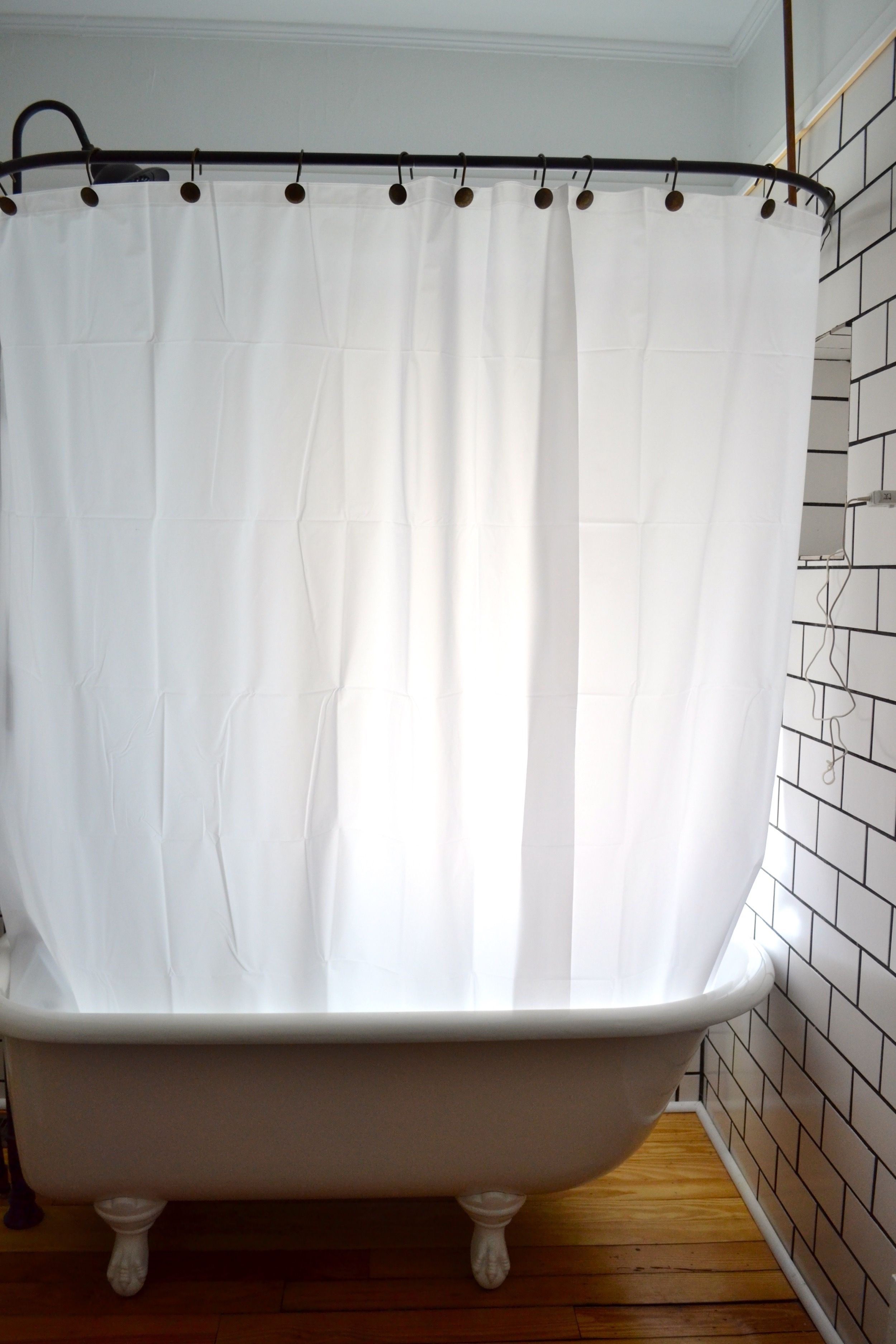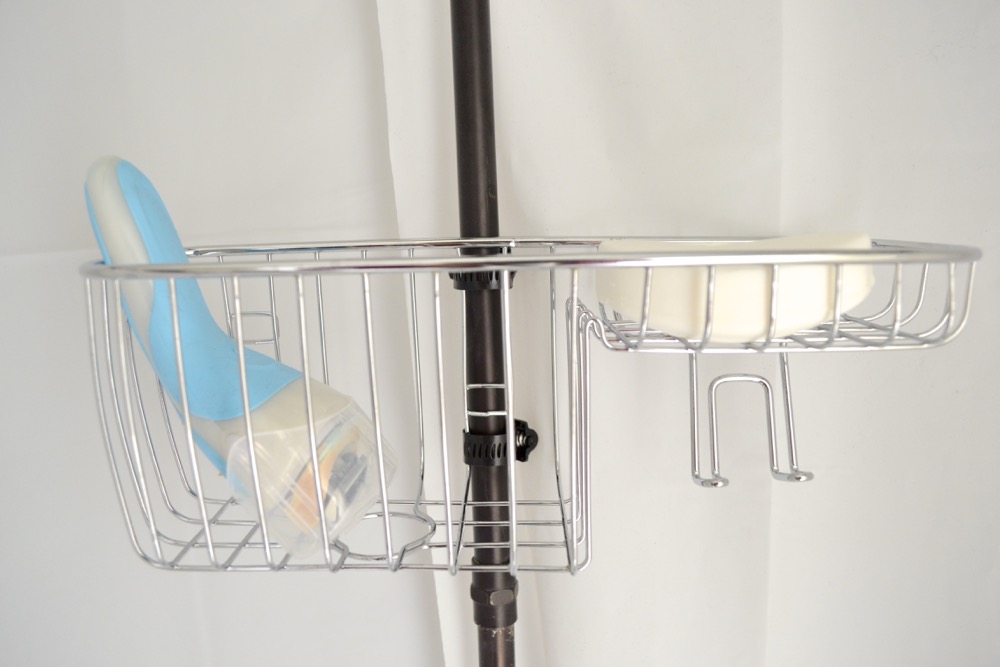Update: several people have asked where they can find the faucet and other shower hardware, at the bottom of the post I’ve added links to what we have as well as some other options.
Happy Friday, friends! Who’s ready for the weekend? I definitely am. and it’s already booked solid with house projects. It’s pretty much been that way since last weekend. Haha! The list keeps growing, fortunately that’s exciting to me.
The most important things I want to get done are installing blinds and getting the upstairs shower in working order. We’re planning on getting faux-wood slat blinds. I won’t go into a lot of detail on them, instead, I’ll link you to this Young House Love post. It’s thorough and we’re doing pretty much the exact same thing. Instead, I’m going to focus on the bathroom.
We’ve been using the shower downstairs since we moved in because it was the easiest one to get in working order quickly. It’s a stall shower, but we put up our regular sized curtain and liner and it works fine. It’s a little too bunchy, but functionally it totally gets the job done. The thing is it’s a pretty small shower and I’m really ready to have more space. The only problem is that our larger bathroom upstairs has a clawfoot tub in it and I’ve never lived with one before. I kept thinking a quick search would give me the info I need to get it ready to use. But, several “quick” searches later and I still didn’t have a ton of information. So, this week I committed to doing a bunch of research on the topic and wanted to share what I’ve learned since I can’t seem to find one good place with general “best practices” when it comes to using a clawfoot tub as your primary shower. Ha! “Best practices” is a really lame term, but it feels like the best (get it!) way to describe it. I just wanted to know, what kind of shower curtain and liner to use, how you store things, are there any tricks to using them, etc. That sort of stuff. Below is everything I’ve found.
1. Decide if you want a clawfoot tub. Some of you (like me) may not have a choice (if that’s you feel free to skip to #2), but if you do, think about all the pros and cons and how it will fit into your home and lifestyle. A few things to consider: the higher sides that can make it hard for older folks and young kids to get in and out on their own; whether or not it will be your primary shower/tub; if the materials around your tub (like the floor) can withstand some extra splashing; and how hard it may be to clean in, around, and under the tub. I found this thread on Apartment Therapy to be somewhat helpful. It has a lot of strong opinions so I’d recommend taking it with a grain of salt.
2. From what I’ve come to understand not all clawfoot tubs are created equally. Their sizes vary a little in terms of how large they are (circumference-wise) and how deep they are. So you’ll want to measure yours and compare it to anything you plan on buying. And even then you’ll probably want to be prepared to either hem it yourself or take it to a seamstress.
3. I found a lot of people said the liner and curtain can be annoying when they billow into the tub and stick to you from all sides. But, every shower curtain liner I could find was too long for my claw foot tub. Meaning, even if I got one with magnets or suction cups, like this one, it wouldn’t help because I'd have to trim them off to fit. If that’s the case for you too, check out my tutorial for making a DIY shower curtain liner to fit your claw foot tub. Another thing that will help is keeping your bathroom warm. The reason the billowing happens is because the temperature outside your tub is significantly cooler than the temperature inside. So, keeping the rest of the bathroom closer to the temperature of your tub while you’re showering will be a big help. I have this space heater and I love it. The plug is safe for use in the bathroom, you can choose the temperature you want it to get to, and it’s really lightweight so it’s easy to move around the house. UPDATE: We’ve been in the house for about a year now. The tutorial for the shower curtain liner and the space heater have been the BEST for keeping the shower curtain from sticking to me. This month has been so cold (single digit temps!) and I haven’t had any sticking when I use the space heater.
4. The hoop shower curtain rod is important. Again, you might not have a choice in this matter because you inherited the tub and its whole set-up. But, if you are adding a clawfoot tub or replacing the rod then be sure to do your research. Rods that are too high or too low can make finding the right shower curtain/liner more problematic. And, finding something that’s very sturdy will give you more options when it comes to storage (see #7).
5. The right curtain/liner will have 36 hooks. Yup, you read that right, 36! Since most packs of hooks come with 12 it means you’ll have to triple whatever you get. I like this classic style (and the fact that it fully surrounds the bar and can’t fall off like the ones you set on top), these simple ones, and if you’re in a predicament like me where someone set-up the rod too close to the wall you might have to splurge on this very thin set.
6. Showering with the liner inside the tub should keep from getting excess water on the floor surrounding it. Another thing that will help is getting one large liner and curtain instead of multiples put together. This way there’s only one opening you have to think about. But, to be honest guys, I haven’t really found any great shower curtains big enough, unless you want plain white or black vinyl. I’m thinking I might have to make my own. UPDATE: I did DIY my own shower curtain! Find the tutorial here. It was so easy and incredibly affordable. It's probably my most used DIY.
7. There’s a lot of debate about what to do with all of your shower stuff. I’ve found several options that seem like they would work. There’s the classic across the tub caddy. The one I linked to is nice because it seems to be a little deeper than many of the others I’ve found and could possibly hold shampoo and conditioner bottles. There are these types, which I really like, but am not sure they’re big enough. And then there are some that can hang on the curtain rod like this or this. I’m thinking something that like that will probably be what we go with.
And that’s what I’ve got so far. I’m going to plan to do an update after we get everything set-up and have been using the shower for a bit. In the meantime, I'd love to know - what have you learned about using your claw foot tub as your primary shower? Anything that's working great? Anything we should avoid? Leave it in the comments! I'd love for this post to become a resource because I've had such a hard time finding one anywhere else.
Below I linked some faucet options. The first one is what we have, but the others look nice too! If you need all the pieces for the entire claw foot tub kit this is what you want.

















